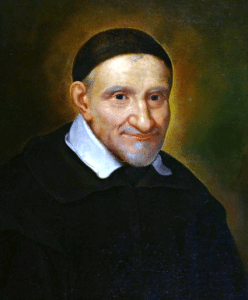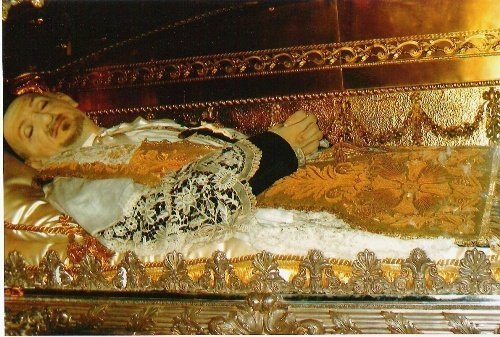A Review of the book
Saint Vincent de Paul
by Father Raymond de Thomas de Saint Laurent
The book, Saint Vincent de Paul is concise and easy to read. Its author, Father Raymond de Saint Laurent wrote it with the same simplicity and benevolence characteristic of Saint Vincent de Paul himself. Just published it has been amply illustrated to enhance the reader’s understanding of this great saint’s life.
Father de Saint Laurent has artfully described Saint Vincent’s qualities. He shows how Saint Vincent was a person who disciplined his thoughts and actions subject to the guidance of Divine Providence. He always waited for Providence to answer his requests and humbled himself by not doing his will, but rather, the will of God. Sometimes in even in the smallest things and having the authority to do, he would not act unless he saw it was the will of God. Once one of his benefactors, Madame Goussalt, asked him to intervene where some abuses had slipped into practice. The saint answered, “God forbid that I should ever place my sickle into the harvest of another.” “One must not preempt Providence,” was an expression he often repeated. He was a man of action and would constantly say that he was only a co-operator in these works; God was the author.
Father Thomas de Saint Laurent recounts the turbulent life of the saint. Born in 1576, ordained to the priesthood in 1600, he suffered many trials and setbacks and did not become a pastor for a number of years after his ordination. He was captured by Moslem pirates and held in captivity for two years after which he escaped with an apostate Italian, whom he succeeded in converting back to Catholicism. It was only in 1617 that he became a pastor and also the chaplain to Queen Marguerite, the separated wife of Henry IV.

contemporary Simon François de Tours
(1606-1671.)
During this time, he started many hospitals, orphanages and frequently visited prisons. Through all of these arduous works, he remained calm and pleasant with everyone despite the tremendous amount of work he had undertaken, because as Father de Laurent states, Saint Vincent possessed treasures of goodness. His bright eyes exuded his charity and his copious undertakings were fruit of his goodness and that, “no one exerts a serious influence upon his surroundings if he is not fundamentally good.” He welcomed all with a beaming smile and charm, and firmly believed that the hours that he sacrificed to charity were never lost.
He saw the wealthy as a reflection of the Divine nobility of Our Lord, and in the poor, His voluntary and sublime poverty. While Saint Vincent received many considerably large donations along with notable recognition from on high, none of this affected his profound humility.
Saint Vincent also led an intense spiritual life. His contemplation of God gave him the graces and strength to accomplish what ordinary men could never do. He was a man of action, but he also was a man of continual prayer. We can see clearly that his action was a mere overflowing of his interior life, which was well nourished. He would often say “There is not much to hope for from a man who does not like to converse with God.” Rising at four in the morning, he would go directly to the chapel to spend an hour in meditation, celebrate daily Mass and afterward, recite his breviary.
Visitors would come by to make consultations of grave matters during which he would remain silent for a few minutes, praying to God for good counsel and then dispense advice. He would bless himself each time that the clock struck the hour or quarter-hour. Saint Vincent said that he saw the soul of Saint Jane de Chantal rise to Heaven in the form of a fiery globe during one of his Masses. He was a humble man who never divulged his prayer life, often recommended communal prayer and would frequently say, “Perfection in love does not consist of ecstasies, but in doing the will of God.”
Most importantly, Saint Vincent had a special devotion to Our Lady. He began this devotion in his youth and increased it throughout his life. Ultimately, he went forward in life after contemplation and prayer, not counting on human support and by doing the Will of God. The book Saint Vincent de Paul by Father de Laurent will help the reader come to understand this extraordinary saint.

To purchase your copy of Saint Vincent de Paul please go to the TFP Store
Or you may also call our Customer Service at (888) 317–5571
Monday — Friday 9:00AM — 5:00PM

